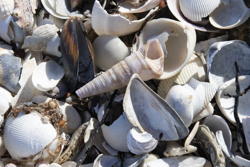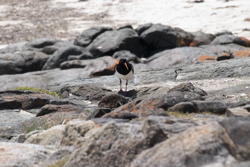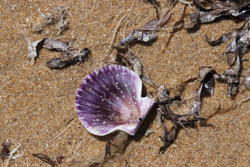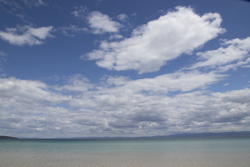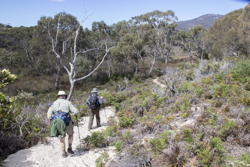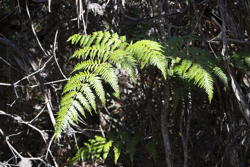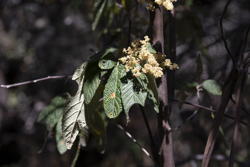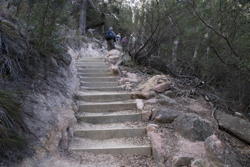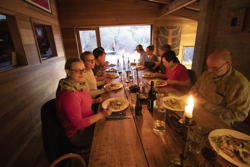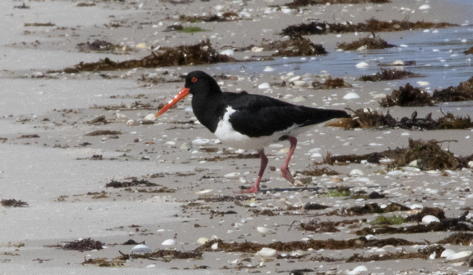
|
| An oystercatcher on the beach (another picture below) |
Saturday, November 10,
with a jaunt on an escalator
Once again, first thing in the morning after breakfast, we took a boat to a beach, Cooks Beach. There were a profusion of shells there, so many different kinds that I did not take a picture of each variety. In the picture to the left, for example, the starring role in the center is taken by some kind of turret snail; you see also a few mussels, many cockles, and others I don’t recognize at all.
I should say that not all of us were on this walk. There was the option of a much more challenging hike, which Heidi and Glenn took with Nick as guide. All the others of the group had James and Isaac as our guides, and as you’ll see below, I found our option plenty challenging enough.
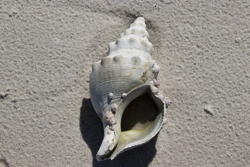
A whelk (big image, small). The barnacles probably settled onto the shell after the snail’s death.
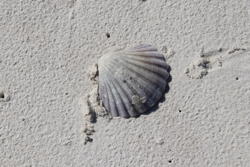
A scallop — Mark has identified it as Pecten fumatus (big image, small).
But let me come back to the shells. My journal reads, «There were cockles, scallops, very large and thick oysterish shells, longish ones [I now realize they were turret snails], at least four kinds of whelks, a bivalve with a complex hinge that caused me to say, with my usual authoritativeness, that it was a Venus clam [like our quahog=hardshelled clam]. More. One beautiful shell that was shaped like a periwinkle but was bigger and brighter.»
Then we turned into the bush for a way, and walked to a “hidden beach” that was part of Hazards Beach. Looking at the map on Mark’s page, I don’t understand why it was considered too isolated or hard to find, except perhaps that it was protected by lots of big rocks, so you wouldn’t be inclined to get to it along the coast.
At this second beach, we had lunch, and from there headed back into the bush. At one point I noticed the shrubs pictured in the upper-left of the block to the right, obviously in the pea family (Fabaceae), but most unpealike in the foliage. It’s a Sweet Wattle (Acacia suaveolens), one of the many Australian plants adapted to drought and fire (big image, small). The image to the right of that shows yet another oystercatcher, one which stood her ground most vocally, in order to defend her nest, we supposed. We made as wide a detour around her as we could, going to the very edge of the water as we passed. (Big image, small.) There’s some question about the nature of the ice-plant shown here. I think it’s Carpobrotus rossii, while Mark identifies it as Disphyma crassifolium. We haven’t come to blows of this disagreement yet, and I don’t suppose we will: the two plants seem to be closely related, even if placed in different genera. I believe that the ice plants that you see everywhere in Southern California are yet different, coming from South Africa rather than Australia.
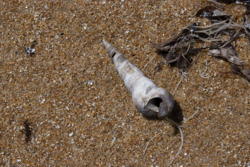
Another turret snail (big image, small).
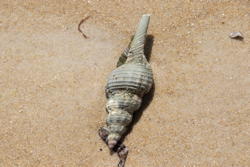
A spindle snail (big image, small).
I’m afraid that my journal turned out to be less helpful than I would like, now, looking back into it. You should really refer back to the map that Mark has for this day. But it seems that the top two and the left picture in the second row to the left were taken on Hazards Beach, while the right picture in the second row shows an early stage on the walk along the Isthmus Track. That track is where I took the two pictures in the third row.
Glenn and Heidi rejoined us on the beach of Wineglass Bay. There was time for some to swim there, and for Mark to take off his boots and wade. We also saw a wallaby up pretty close. The picture is the best one of the several I got. From there we started to climb on what the map calls the Wineglass Bay Track, but which the guides called The Escalator.
In fact, my journal reads, «Then the last section, which James referred to as The Escalator. I had no idea what that meant, and as we got to the top of it, I found out. Virtually the whole ascent was by means of stairs; at the bottom, approximately 2″×8″ risers of wood, filled in with soil; towards the top, blocks of granite, less carefully modulated and mostly not cut flat. At the top, a resting place, with lots of big rocks to lean agains or even to sit on. This is where Mark got a fine shot of a rock orchid, tiny yellow. I for one pulled out my iPhone with its satellite (GPS)-based compass application, to find that while we had started at sea level, we were now at an elevation of 810 feet. Afterwards, someone said that we had gone up 1000 steps.
«The way down was stepped, too, and this put a tremendous strain on my leg muscles, probably the knee tendons too, so that by the time we got to the bottom, I was trembling at the knees. The Weak-Kneed Geezer. James was watching over me, as sweeper, and he complimented me profusely. I think that M must have told him my true age.» My journal suggests that I was uncertain how to accept these compliments.
It was a relief to get back to the lodge and relax with a glass of wine. We were learning to expect superb meals here, especially the dinners. Tonight it was quail and pumpkin gratin, also cauliflower. Salads here are terrific, too. Dessert was rhubarb with vanilla ice cream. Yum. As the night before, James gathered us in the lounge to give a preview of the next day’s walk. And then to bed, to rest ahead for another big day. You can read all about it on the next page.
